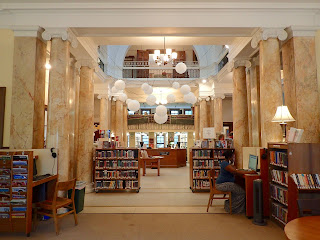Willsboro Bay, NY. We spent a quiet night in this large bay after yesterday's bumpy crossing from Burlington, VT. The forecast for this day was nearly the same, winds 10-20 knots, seas 1-3, so pulled anchor early and headed for another refuge.
Not far down the lake we turned up the Otter Creek leading to Vergennes.
This nine mile cruise up this skinny creek was a Disney ticket. Heavy rains had raised the level five feet above normal and churned the silty waters to a beautiful leathery tan.
With a few bends to go, mysterious foam started to appear, which grew heavier as we proceeded to the town dock.
Just like Disney, the river opened into a beautiful basin below raging waterfalls. And the water was even more sudsy.
A local reassured us that it was just naturally occurring silt stirred up by the rains, not an inundated soap factory somewhere upstream. The Seymour family water expert offered us to this reassuring explanation. https://www.michigan.gov/documents/deq/deq-oea-nop-foam_378415_7.pdf .
Vergennes was Vermont's first city, which grew with the resources provided by the falls and Lake Champlain. It thrived in the 1800s with manufacturing, trade and culture. There were farms, a grist mill, wood building products, and Vermont's largest tannery. Today the town lacks the visible industry and is attractive with well-kept homes, restaurants, and shops.
 |
| The Bixby Memorial Free Library |
The library was originally a bank building. Note the marble columns. What a great space for research and solitude.
How many libraries have a spectacular dome?
The town dock is free including electricity and water. Jeanne and Bob have expectations for each town they visit: coffee shop, bakery, and ice cream shop. Vergennes had two out of three. But it also had a bonus: a chocolate shop where Bob bought a box of chocolates for his bride of five years.
Happy Anniversary Jeanne and Bob!
The following morning we retraced our 9-mile track back down Otter Creek to the Lake and cruised south to Mile Point Bay to visit the Lake Champlain Maritime Museum.
The first exhibit onshore provided insight to the true mission of this museum. A replica of Benedict Arnold's gunboat Philadelphia was tied to the dock. The original warship was built in 1776 for Arnold's fleet to keep the British from regaining control of Lake Champlain. During the Battle of Valcour Island in the northern waters of the lake, it was sunk and sat on the bottom for 160 years. It was located and raised in 1935 and hailed as an important connection with the past. Today she resides in the Smithsonian. Decades later the Lake Champlain Maritime Museum built a replica of this boat and today it enjoys multiple recreational and educational applications. This project represents the museum's dedication to life-long learning through the discovery and care of Lake Champlain's maritime heritage.

The museum proper houses a fine collection of maritime memorabilia with emphasis on Lake Champlain.
Iceboats were once the fastest vehicles on earth. They could go five times as fast as the wind due to minimal surface drag. These boats were found in all parts of the world (with ice).
They were very popular in Holland, and were brought to America by the Dutch who sailed then on the Hudson River.
Thanks for the dedicated people of the museum for this great collection and ongoing stewardship of beautiful Lake Champlain. For more info: http://www.lcmm.org

















You constantly remind me that it's the journey that matters, and your detour to Vergennes epitomizes this point. Interested in more about your leathery brown, sudsy water? Your concerns surface (pun intended) for people living near drinking water systems' intakes and the non-problem is explained well here: https://www.michigan.gov/documents/deq/deq-oea-nop-foam_378415_7.pdf .
ReplyDeleteThank you, Laurie! It's good to know that locals gave correct information. I'm posting the link.
Delete